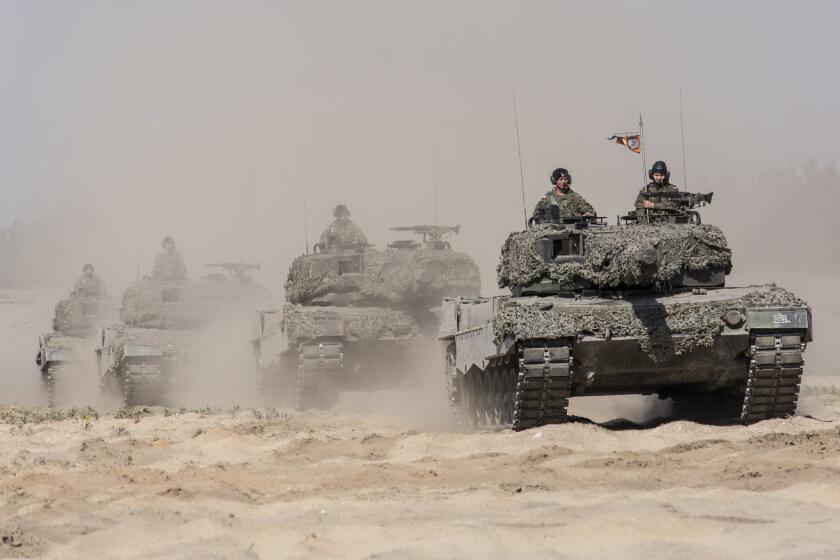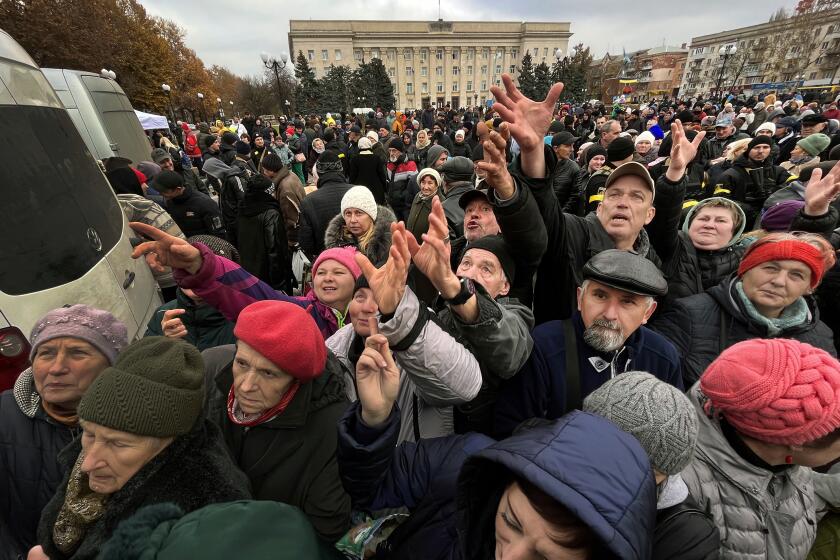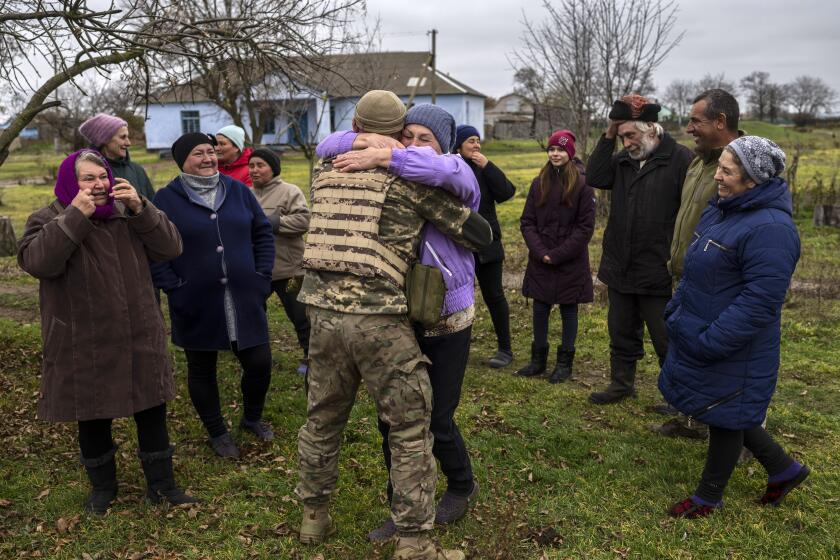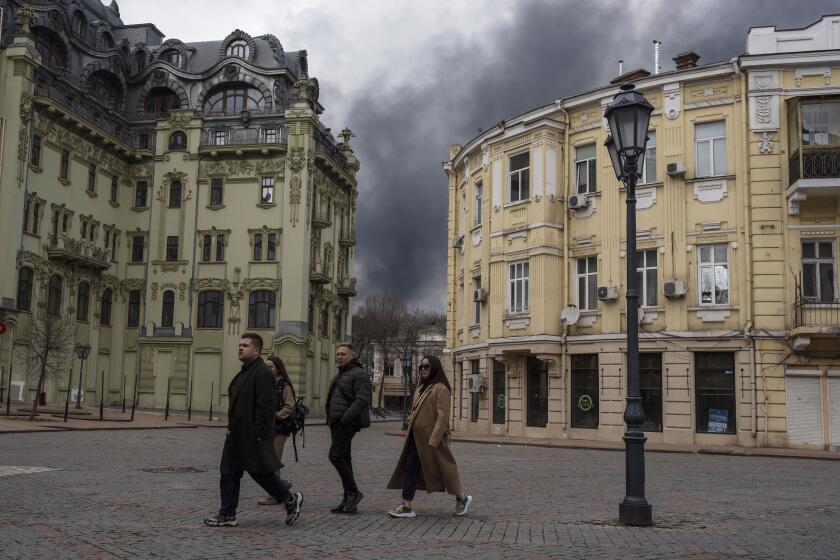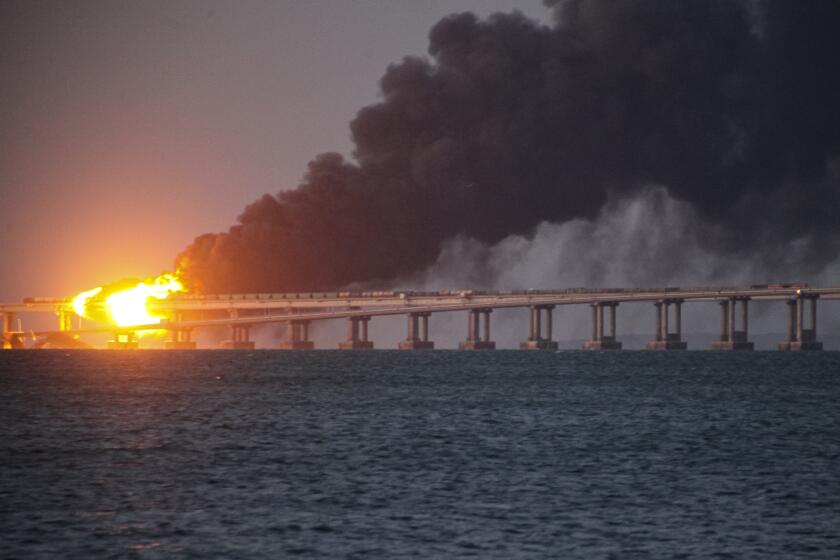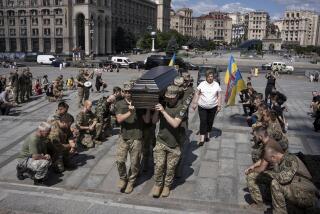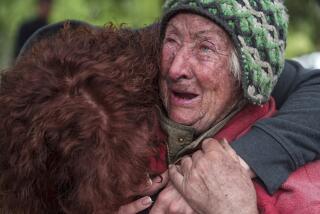Russians may be gone, but fear and hardship remain in a recaptured Ukrainian village
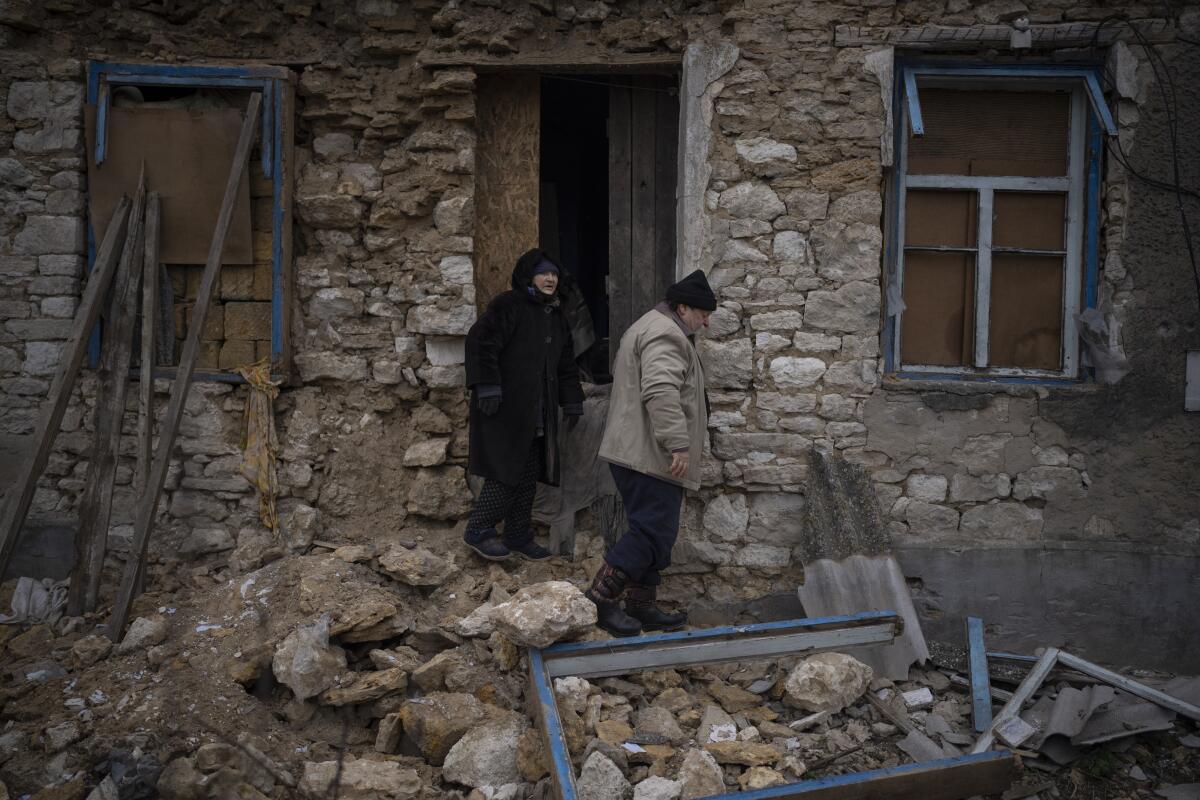
- Share via
KALYNIVSKE, Ukraine — When night falls in Tatiana Trofimenko’s village in southern Ukraine, she pours sunflower oil that aid groups gave her into a jar and seals it with a wick-fitted lid. A flick of a match, and the make-do candle is lit.
“This is our electricity,” Trofimenko, 68, says.
It has been more than 11 weeks since Ukrainian forces wrested back her village in Kherson province from Russian occupation. But liberation has not diminished the hardship for residents of Kalynivske, both those returning home and the ones who never left. In the peak of winter, the remote area not far from an active front line has no power or water. The sounds of war are never far.
Russian forces withdrew from the western side of the Dnipro River, which bisects the province, but remain in control of the eastern side. A near-constant barrage of fire from only a few miles away and the danger of leftover mines have made normality an elusive dream and cast a pall over the Ukrainian military’s strategic victory.
Still, residents have slowly trickled back to Kalynivske, preferring to live without basic services, dependent on humanitarian aid and under the constant threat of bombardment rather than live as displaced people elsewhere in their country. Staying is an act of defiance against the relentless Russian attacks intended to make the area unlivable, they say.
“This territory is liberated. I feel it,” Trofimenko says. “Before, there were no people on the streets. They were empty. Some people evacuated; some people hid in their houses. When you go out on the street now, you see happy people walking around.”
The wariness over military involvement that made Germany hesitate to send tanks to Ukraine is rooted in the country’s memories of World War I and II.
The Associated Press followed a United Nations humanitarian aid convoy into the village Saturday, when blankets, solar lamps, jerrycans, bed linens and warm clothes were delivered to the local warehouse of a distribution center.
Russian forces captured Kherson province in the early days of the war. The majority of the nearly 1,000 residents in Kalynivske remained in their homes throughout the occupation. Most were too frail or ill to leave, and others did not have the means to escape.
Gennadiy Shaposhnikov lies on the sofa in a dark room, plates piled up beside him.
The 83-year-old’s advanced cancer is so painful that it is hard for him to speak. When a mortar destroyed the back of his house, neighbors rushed to his rescue and patched it up with tarps. They still come by every day, to make sure he is fed and taken care of.
Kherson, the provincial capital occupied by Russia, is back in Ukrainian hands. But its people face privation, along with neighbor-against-neighbor suspicions.
“Visit again, soon,” is all he can muster to say to them.
Oleksandra Hryhoryna, 75, moved in with a neighbor when the missiles devastated her small house near the village center. Her frail figure steps over the spent shells and shrapnel that cover her front yard. She struggles up the pile of bricks, what remains of the stairs, leading to her front door.
She came to the aid distribution center pulling her bicycle and left with a bag full of tinned food, her main source of sustenance these days.
But it’s the lack of electricity that is the major problem, Hryhoryna says. “We are using handmade candles with oil and survive that way,” she says.
Families were torn apart when Russia invaded Ukraine as some members fled and others hunkered down, including in the recaptured city of Kherson.
The main road that leads to her home is littered with the remnants of the war, an eerie museum of what was and what everyone here hopes will never return. Destroyed Russian tanks rust away in the fields. Cylindrical antitank missiles gleam, embedded in grassy patches. Occasionally, there is the tail end of a cluster munition lodged into the earth.
Bright red signs emblazoned with a skull warn passersby not to get too close.
The Russians left empty ammunition boxes, trenches and tarp-covered tents during their rapid retreat. A jacket and, some miles away, men’s underwear hang on the bare branches of trees. And with the Russians waging ongoing attacks to win back the lost ground in Kherson, it is sometimes hard for terrorized residents to feel as if the occupying forces ever left.
“I’m very afraid,” says Trofimenko. “Even sometimes I’m screaming. I’m very, very scared. And I’m worried about us getting shelled again and for [the fighting] to start again. This is the most terrible thing that exists.”
Breaking News
Get breaking news, investigations, analysis and more signature journalism from the Los Angeles Times in your inbox.
You may occasionally receive promotional content from the Los Angeles Times.
The deprivation suffered in the village is mirrored all over Kherson, from the provincial capital of the same name to the constellation of villages divided by tracts of farmland that surround it. Ukrainian troops reclaimed the territory west of the Dnipro River in November after a major counteroffensive led to a Russian troop withdrawal, hailed as one of the greatest Ukrainian victories of a war that’s now in its 12th month..
The U.N. ramped up assistance, supporting 133,000 individuals in Kherson with cash assistance and 150,000 with food. Many villagers in Kalynivske say the food aid is the only reason they have something to eat.
“One of the biggest challenges is that the people who are there are the most vulnerable. It’s mainly the elderly, many who have a certain kind of disability, people who could not leave the area, and are really reliant on aid organizations and local authorities who are working around the clock,” says Saviano Abreu, a spokesperson for the U.N. Office for the Coordination of Humanitarian Affairs.
The shelling is constant.
The United Nations’ cultural agency has added the historic center of Ukraine’s Black Sea port city of Odesa to the list of endangered World Heritage sites.
Ukraine’s Defense Ministry reports near-daily incidents of shelling in Kherson city and surrounding villages, including rocket, artillery and mortar attacks. Most fall close to the riverbanks near the front line, but that doesn’t mean those living farther away feel any safer. On Friday, a missile fell in the village of Kochubeivka, north of Kalynivske, killing one person.
“Kherson managed to resume most of the essential services, but the problem is the hostilities keep creating challenges to ensure they are sustained,” Abreu says. “Since December, it’s getting worse and worse. The number of attacks and hostilities there is only increasing.”
Without electricity, there is no means to pump piped drinking water. Many line up to fetch well water, but a lot is needed to perform daily functions, residents complain.
To keep warm, many forage around the village for firewood, a task that presents danger post-occupation.
Ukraine sees Crimea, the strategic peninsula illegally annexed by Russia nearly nine years ago, as potentially within its grasp.
Everyone in Kalynivske knows the story of Nina Zvarech. She went looking for firewood in the nearby forest and was killed when she stepped on a mine.
Her body lay there for more than a month because her relatives were too afraid to go and find her.
More to Read
Sign up for Essential California
The most important California stories and recommendations in your inbox every morning.
You may occasionally receive promotional content from the Los Angeles Times.
